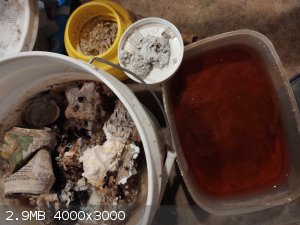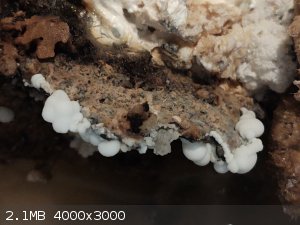Chemgineer
Hazard to Others
  
Posts: 216
Registered: 25-5-2021
Member Is Offline
|
|
Sodium aluminate
I planned to use some scrap aluminium and sodium hydroxide solution to produce some sodium aluminate however I used a concentrated hydroxide solution
and instead of sodium aluminate going into solution I now have a white/grey semi solid suspension.
Rather than dispose of this, how can I get this into a useful solution?
|
|
|
blogfast25
International Hazard
    
Posts: 10562
Registered: 3-2-2008
Location: Neverland
Member Is Offline
Mood: No Mood
|
|
Quote: Originally posted by Chemgineer  | I planned to use some scrap aluminium and sodium hydroxide solution to produce some sodium aluminate however I used a concentrated hydroxide solution
and instead of sodium aluminate going into solution I now have a white/grey semi solid suspension.
Rather than dispose of this, how can I get this into a useful solution? |
Try diluting it. NaAl(OH)4 is very water soluble but not infinitely soluble either.
|
|
|
Junk_Enginerd
Hazard to Others
  
Posts: 251
Registered: 26-5-2019
Location: Sweden
Member Is Offline
|
|
I would also appreciate learning more about this. I have the same experience with NaOH and aluminium. Most of what is created does not seem soluble at
all, unlike what chemical reaction descriptions state.
|
|
|
Rainwater
National Hazard
   
Posts: 919
Registered: 22-12-2021
Member Is Offline
Mood: indisposition to activity
|
|
The lack of details makes this question difficult to answer.
What was the source of the aluminum?
Could you list the amounts of reagents used?
A thick gel like material is to be expected when consentrated
"You can't do that" - challenge accepted
|
|
|
violet sin
International Hazard
    
Posts: 1480
Registered: 2-9-2012
Location: Daydreaming of uraninite...
Member Is Offline
Mood: Good
|
|
Likewise I have a bucket dedicated to aluminate. Scrap aluminum and lye. It has produced several rounds of light amber solution and ends up crusting
the aluminum in white semitransparent to opaque deposits. After the teeth wear down on the solution, nearing saturation, some aluminum is almost
fossilized, being replaced as it stands with hydrated hydroxide.
If I had to guess based on observation, the solution action on free metal is sufficiently easy, it has no problem replacing anything precipitated due
to carbon dioxide absorption. My projects were long ranged and rarely checked. Had to break up the coating to get it dissolving more. It was
mainly soda can and various bits of aluminum scrap from construction sites. But in the end I had a pile of stuff that wasn't precipitated aluminate.
It was insoluble and in a few cases rudely adhered against physical scraping.
Now I've got some more interesting nodules growing off the remnants after decanting. Some dried powder mixed with partially consumed aluminum and
some amber solution over settled fines from the last decanting. Not the prettiest project, but it's easy sailing for the most part.
 
|
|
|